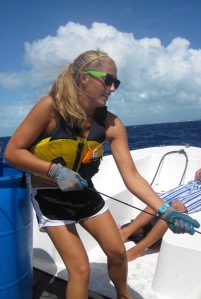
Written by Aubrey, Taylor, Dorothy, Ally, Clay, Liam
Not many are aware that little to no information is known on 90% of the ocean. Our goal as the Deep Water Shark research team is to collect data on deep-water shark species, and maybe even discover new species. Through use of 1100 meters of line and extensive deep water surveying, we are catching and tagging deep-water elasmobranchs. After in depth analysis, we hope that this new data will provide a basis for future Island School semesters, but more importantly it will provide knowledge and data for fisheries of the Bahamas, and other researchers.

With little knowledge on what we were doing, we spent our first day out on the water with Dr. Dean Grubbs, an experienced shark researcher and professor from FSU, hauling up the line from the depths of the ocean. Our first day was very successful, as we caught two Big-eyed sixgill sharks, and two Cuban dogfish. We all left the boathouse that day with anticipation and excitement for what we would pull up the next week.
This afternoon officially started when we hopped on the Mac Daddy (Island School boat!) into the very rough ocean to pull up our deep water survey. We made our way out until the turquoise water turned navy blue; boat rocking beneath us, we prayed we wouldn’t get sea sick. We combined our flexing muscles to pull up the 1100 meters of line with hopes that a shark had taken the bait. As the line got more tangled, anticipation teemed from every member of the Deep Water team. Our efforts became worthwhile when Edd (head of the shark program) saw a dark shadow rising from the deep ocean. As it came onto the boat, we recorded the time and identified it as the rare species, a Bigeye sixgill. We measured and tagged the shark, and ran our fingers up and down the sharks skin. Rough one way, smooth the other. Edd swam him down safely, and the tangled line he created was worthwhile. We came back in one piece, land legs intact and cleaned the Mac Daddy. In celebration of our successful trip to sea, the six of us jumped off the dock.

We have caught two species of deep-water sharks in our two research blocks. The first species we caught was the smaller of the two, the Cuban dogfish. The Cuban dogfish is a small shark that lives from 60 meters to around 380 meters. One interesting fact about the Cuban dogfish are the two sharp spines on the dorsal fins, these are used for protection so you have to be careful handling them. The second shark we hauled up was the Big-eye sixgill shark. This shark is a larger shark that can reach up to two meters in length. The Big-eye sixgill is very interesting because they are one of the rare species that have more than five gills, and they also have unique eyes to optimize the amount of light at the depths where they live. We are some of the few people in the world to see it. Both of these sharks were very interesting to look at and learn more about. We hope in further research days we can catch different species and expand our knowledge of the deep-water environment.



